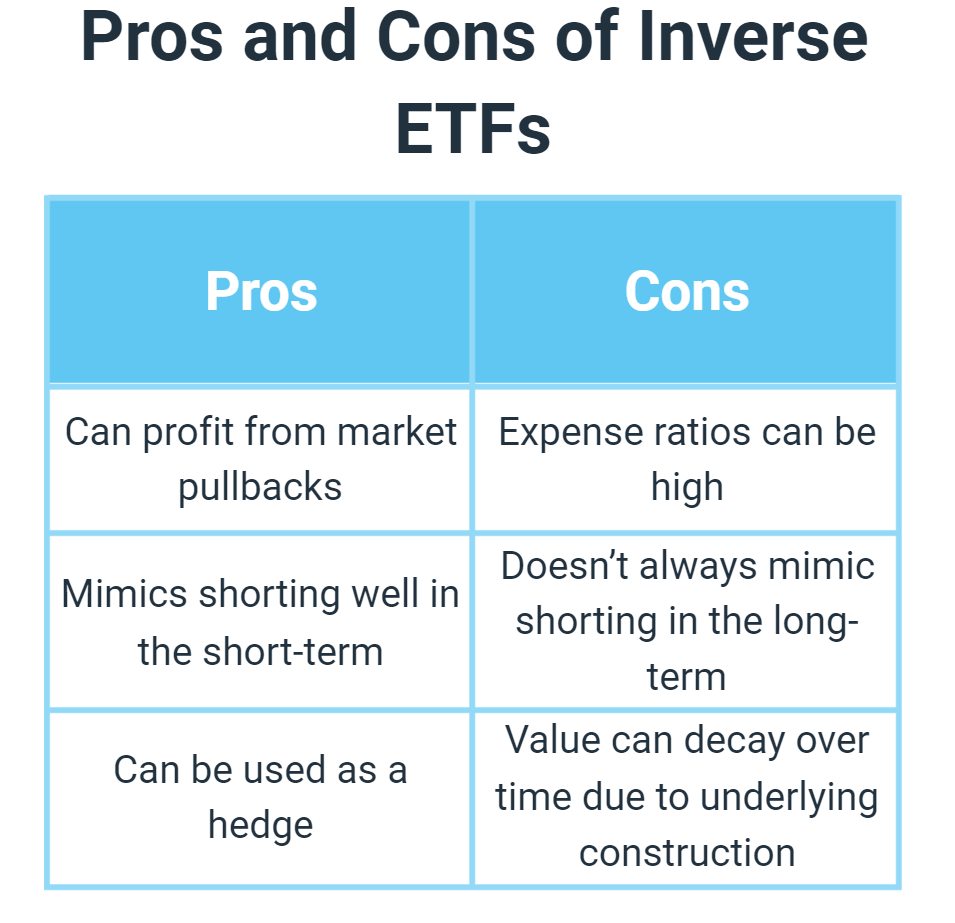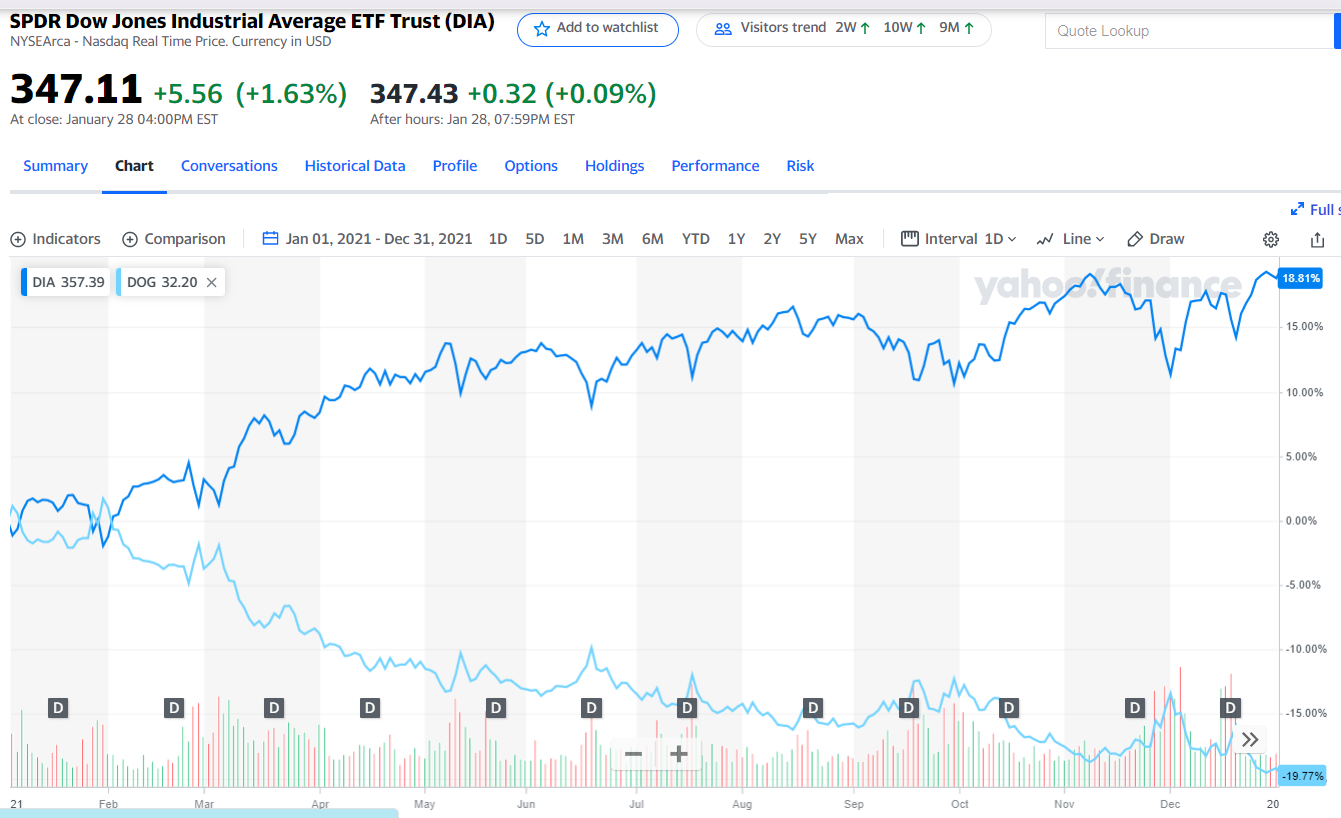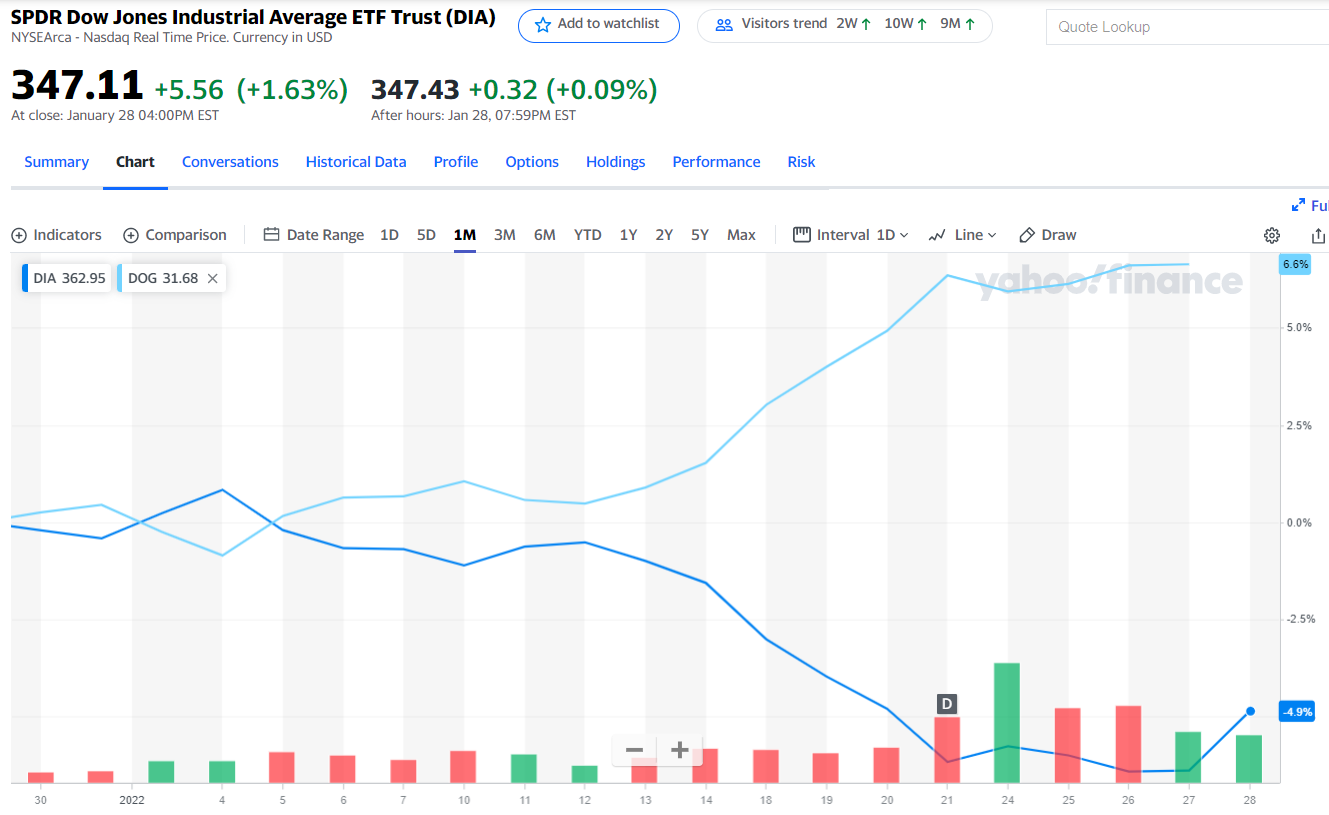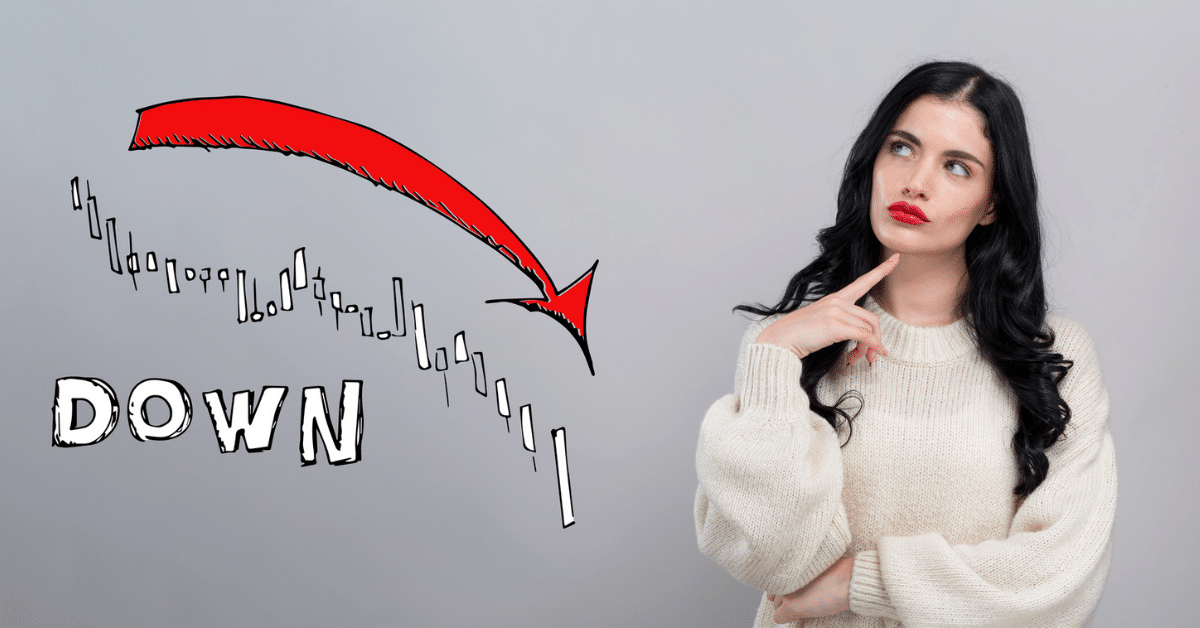Investors anticipating a bear market, when stock prices fall, might be wondering, “How do I profit from declining asset prices?” After more than a decade-long bull market, a turnaround is bound to occur. Short or inverse ETFs might be the way to profit when markets fall.
Contents
What is Short Selling?
Short selling is an advanced investment strategy and requires you to open a margin account. Investors, who think an asset or market index will decline in price, attempt to profit by selling short. A trader borrows assets from their investment broker to sell in the open market at the current price. Then, after the price declines, she will buy these same assets on the open market, return the borrowed shares and profit from the difference between the buy and sale price, less transaction costs.
Short selling is risky. If the asset price rises instead of declines in price you’ll need to “cover your short” or buy the asset shares back on the open market at a higher price, for a loss, and then return the shares to the investment broker. Short selling can also be expensive, as you’ll pay interest on the borrowed shares.
Inverse ETFs typically use derivatives to allow investors to mimic a short position without being exposed to the risk that comes with short positions. The stock market offers these inverse ETFs on most of the major indexes (e.g., the S&P 500 and the Dow Jones Industrial Average) and many more specified areas (e.g., the semiconductor sector and treasury yields). An inverse ETF can be extremely useful for investors who have bearish outlooks for the market or a certain sector in the market.
Why Should I Buy an Inverse ETF?
A short position, as an investment strategy, is naturally of high risk due to limited potential gains and infinite potential losses. This is why inverse ETFs are preferable: You switch the limited gains to unlimited gains and infinite losses to finite losses. Some investors like holding inverse ETFs in their portfolios to hedge against downturns in the market.
In a bear market, such as the market in 2020 when the pandemic first hit, or in January, 2022, many investors with inverse ETFs likely saw a pool of red upon opening their portfolios, with the only exception being their inverse ETFs. Sometimes a single asset class can protect your portfolio from a large unrealized loss. Inverse short ETFs constitute one such class; puts constitute another option you should consider.
Pros and Cons of Short Market ETFs
Enter inverse ETFs. These financial instruments solve the “short selling” problems but also introduce problems of their own. While you do not need to be qualified or put up margin for inverse ETFs, they are flawed in their construction and come with expense ratios.
Before investing, understand the pros and cons of inverse ETFs.

How Short ETFs Work
What is an Inverse or Short ETF?
Inverse or Short ETFs are exchange-traded funds created to offer the opposite daily returns of a specific index. The best inverse ETFs produce a daily performance directly opposite of its benchmark index. This is great, when markets are declining. When markets drop, you’ll have the inverse ETF to prop up your losses. But, when markets are advancing, short ETFs drop in value.
Because inverse ETFs use derivatives contracts as the assets under management, they do not perfectly track the underlying benchmark. So, you’ll find imperfect opposite returns in the short ETFs.
Let’s compare the 2021 inverse ETF, ProShares Short Dow 30 (DOG), which tracks the opposite performance of the Dow Jones Industrial Average. In this comparison, we’ll use the SPDR Dow Jones Industrial Average ETF Trust (DIA).
Inverse ETF Performance During a Bull Market – DOG vs DIA
During 2021, the Dow Jones Industrial average, as represented by SPDR Dow Jones Industrial Average ETF Trust (DIA) gained 18.81%. While the short ETF, ProShares Short Dow 30 (DOG) lost -19.71%. Not a great return for the inverse ETF, because of the stellar performance of the DJIA.

Inverse ETF Performance During a Declining Market – DOG vs DIA
Here’s where the short ETF does it’s work. During the January, 2022 declining market, the SPDR Dow Jones Industrial Average ETF Trust (DIA) lost 4.5%. While the ProShares Short Dow 30 (DOG) advanced 6.2%.

What is Leveraged Short Selling?
We have already discussed short selling – but what happens when we add leverage, the use of borrowing or employment of financial instruments to increase the potential return (or loss) of your investment position? The answer depends on the type of leverage. If you are leveraging via borrowing funds, such as by using margin, you greatly increase the risk of experiencing a large loss should the individual stocks you’re shorting only need move upward slightly for the brokerage to consider the position too dangerous, liquidating it for you at a loss.
However, should you leverage via options, you can do so with limited risk. Consult the “puts” section in my options guide for more on this aggressive short selling strategy.
Lastly, you have leveraged ETFs. Leveraged ETFs are built like normal ETFs – and thus available on the stock market for retail investors – but structured in a way to move not 1-to-1 against the underlying index but 2x or 3x against the underlying. Inverse ETFs also come in leveraged form, such as in the ProShares short ETFs. You can check the ETF database to find the best inverse ETFs of this type.
Leveraged inverse ETFs offer greater returns when markets decline along with greater losses during advancing markets.
When Should I Buy an Inverse ETF?
While this is almost certainly a question best for your financial advisor, who presumably knows your risk tolerance, here are some general guidelines for deciding on when to buy an inverse ETF. The best time to buy an inverse ETF is before a market, or sector decline.
If your portfolio is 100% long, you can reduce your market risk, or possibility of declines in your investment portfolio, by adding in an inverse ETF. As an inverse ETF is essentially a short position, designed to increase returns when the general market drops. Hedging is common investing advice, and holding inverse ETFs in your portfolio is one form of hedging.
You can also check the ETF database to find any inverse ETFs that would help you hedge your exposure to a certain sector. For example, if you hold many technology stocks in your portfolio but are worried about a potential decline in the technology sector, you can buy REW, which is a ProShares short ETF, with leverage, focused on the technology sector.
Finally, you can use inverse ETFs to gain positive returns should you expect a market or sector to pull back. You might, for example, buy the ProShares short leveraged ETF on natural gas, KOLD, should you expect the price of gas to fall. An ETF holding like this is speculative but comes with finite losses due to not being a true short position.
Where and How to Buy ETFs That Short the Market?
The best inverse ETFs might require some research to find, but once you do find them, they are easy to purchase. Simply use your brokerage firm and search for the ETFs’ tickers. Then, buy them as you would a normal stock or ETF.
How to Choose Which Inverse ETFs to Buy
When choosing an ETF, you have several points to consider:
- Liquidity: The average volume of an ETF can give you a hint as to how easy the position will be to enter and exit. More volume means more transactions, meaning better bid/ask spreads and liquidity. When you can, avoid lower liquidity choices in favor of ETFs with high volumes. AUM – assets under management – can also be an indicator of liquidity.
- Expense ratio: Each ETF – inverse or not – carries an expense ratio. The “expense ratio” is simply a fee paid to the fund management. The expense ratio varies across ETFs, but inverse ETFs tend to carry higher fees.
- Leverage: Leverage typically comes in three forms: 1x, 2x, and 3x. The 1x leveraged ETFs are simply normal ETFs, tracking the underlying index 1-to-1 (and inverted, for inverse ETFs). The leveraged forms, 2x and 3x, are either explicitly stated as 2x or 3x short or employ the term “ultra,” such as with the ProShares Ultrashort S&P500 ETF, SDS.
- Past performance: In general, past performance has no bearing on a fund’s daily performance in the present. While momentum does exist, so does mean-reversion, the former predicting a continued trend while the latter predicts a trend reversal. However, momentum has been documented in commodities trading, which means that past performance can be a good predictor for ETFs in commodities markets, such as the oil market.
5 Best ETFs that Short the Market 2022 + Bonus
Here is our opinion for the best inverse ETFs for the average investor for 2022. These are sector specific ETFs and selected based upon our economic and market research. The bonus listing is for investors who expect a bear market in the S&P 500 this year.
1. ProShares Short 20+ Year Treasury (TBF)
- Expense ratio: 0.94%
- AUM: $700M
- Daily volume: $26M
This ETF is short long-dated bonds. I highly recommend you consider TBF if you are concerned about rising interest rates, which seems to be the story for 2022 and onward. It comes with no leverage and is thus a conservative choice for hedging a hawkish Fed.
2. ETFMG 2X Daily Inverse Alternative Harvest ETF (MJIN)
- Expense ratio: 0.95%
- AUM: $800K
- Daily volume: $15K
MJIN is a 2x leveraged play against the cannabis sector and the largest cannabis ETF as of 2022. As the cannabis sector is full of companies that are still unprofitable, MJIN represents an opportunity to profit from the downward momentum in this sector. MJIN can also be used in conjunction with a cannabis stock position, allowing you to hold your favorite marijuana stock while still hedging against this still unprofitable industry.
3. Direxion Daily Semiconductor Bear 3X Shares (SOXS)
- Expense ratio: 1.08%
- AUM: $99M
- Daily volume: $104M
SOXS shorts semiconductor stocks, with top holdings (as inverse positions) of Intel, Broadcom, and Nvidia, with 3x leverage. The semiconductor industry is highly volatile and subject to political conflicts, especially those between the US and China. Slowing growth in the semiconductor industry and political uncertainties put the sector at risk, making SOXS a good hedge if you hold semiconductor stocks.
4. Direxion Daily MSCI Real Estate Bear 3x Shares (DRV)
- Expense ratio: 1.08%
- AUM: $20M
- Daily volume: $3M
The popularity of real estate in the recent years has brought prices to an all-time high. However, as the Federal Reserve seeks to raise interest rates, mortgage rates are on the rise. If you own real estate or REITs, DRV can help you hedge the increasingly risky real estate market.
5. Direxion Daily Financial Bear 3X Shares (FAZ)
- Expense ratio: 1.07%
- AUM: $124M
- Daily volume: $47M
Financial stocks tend to fall hard when economic conditions become weak. From an economic perspective, 2022 is likely to be a year of decreased economic growth, putting strain on financial large cap and small cap stocks. Large cap stocks are more at risk here, as small caps can benefit more from rising interest rates – and that makes FAZ a great choice for this scenario, as FAZ takes short positions on the large cap financial stocks.
Bonus:
If you think the entire S&P 500 is due for a bear market, then consider the Direxion Daily S&P 500 Bear ETF (SPDN) which is created to offer 1x inverse exposure to the popular Standard and Poor’s 500 index.
Best Inverse ETFs to Short the Market | Wrap Up
Whether you expect a bear market or are just too overexposed to a certain index, you might improve your overall investing performance by adding inverse ETFs to your portfolio. Strategic investors can locate a trend in the market, using an aggressive leveraged inverse ETF to gain large returns. Conservative investors can balance their portfolio, using inverse ETFs to reduce market and sector risk.
But in the end, both are playing it rather conservatively by using inverse ETFs, paying an expense fee instead of taking on the unlimited risk that comes with shorting stock.


